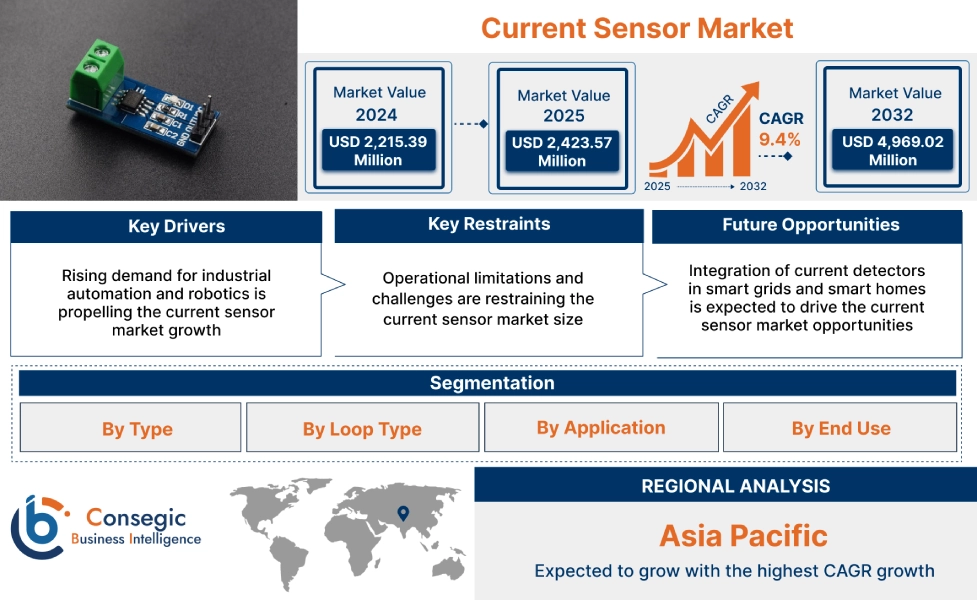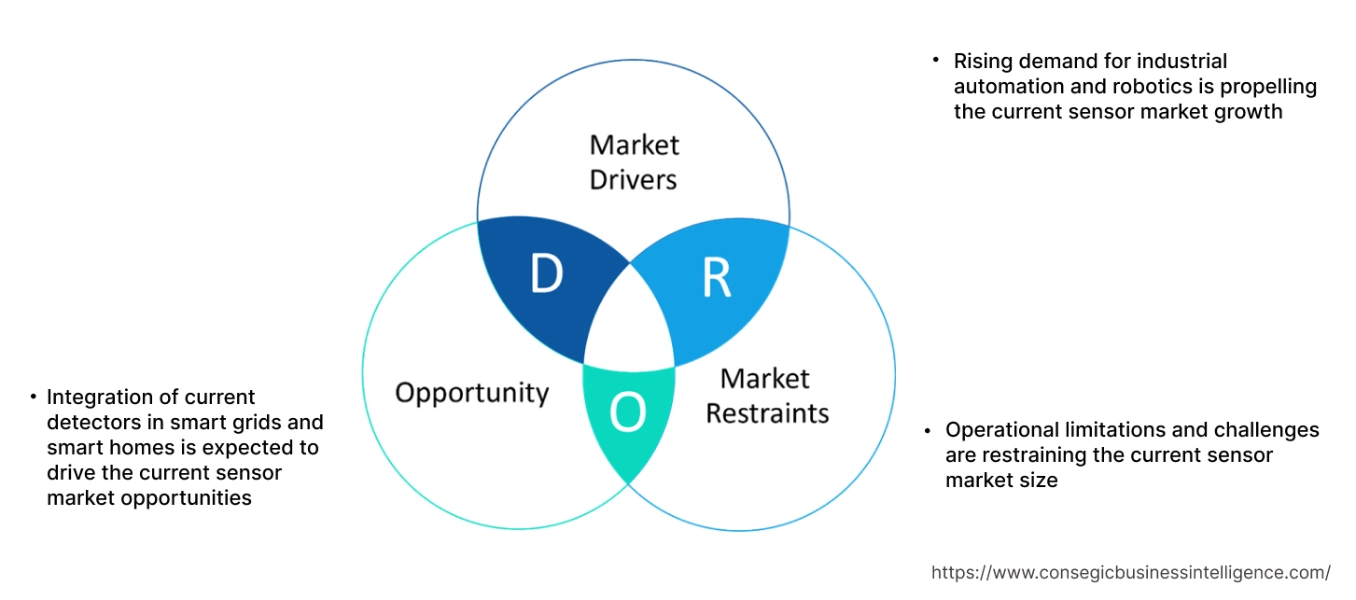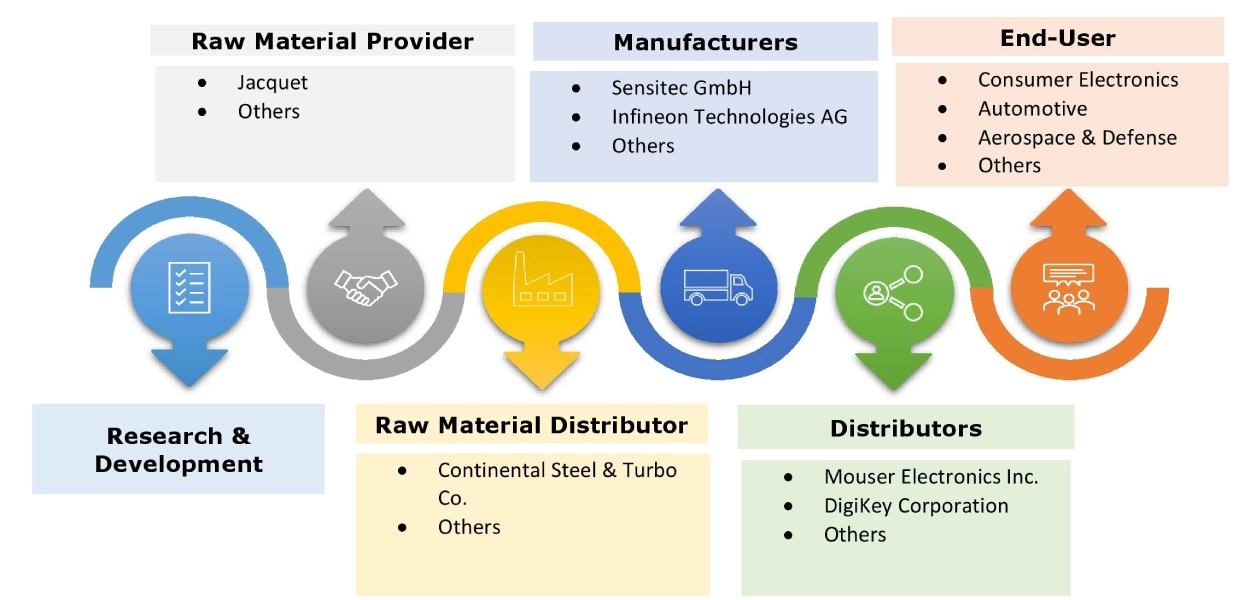Current Sensor Market Size:
Current Sensor Market size is estimated to reach over USD 4,969.02 Million by 2032 from a value of USD 2,215.39 Million in 2024 and is projected to grow by USD 2,423.57 Million in 2025, growing at a CAGR of 9.4% from 2025 to 2032.
Current Sensor Market Scope & Overview:
Current sensors, also known as current detectors, are vital components in a wide range of electrical and electronic systems which ensure that the equipment and gadgets operate efficiently. They detect and measure the electric current passing through a conductor. Moreover, sensors are derived from various essential physical concepts like Ohm's law, faraday's law, magnetic field, and optical sensing. Further, they have several applications across numerous sectors such as consumer electronics, automotive, energy & power, aerospace & defense, and others, which are further driving the market.
How is AI Impacting the Current Sensor Market?
AI is significantly impacting the current sensor market by enabling more intelligent, adaptive, and efficient sensing systems. AI algorithms process real-time sensor data to improve measurement accuracy, enable predictive maintenance, and optimize energy usage in various applications, from electric vehicles to smart grids. Also, AI-powered current sensors can monitor energy consumption in real-time and optimize energy usage, leading to significant energy savings in various applications. Thus, the integration leads to more precise current measurement, fault detection, and adaptive load management, ultimately enhancing performance and reliability.
Key Drivers:
Rising demand for industrial automation and robotics is propelling the current sensor market growth
Current sensors are essential components in industrial automation and robotics, which play a primary role in controlling motors and actuators, monitoring motor currents, and others. The use of these sensors in robotics detects the anomalies in current flow to prevent damage or accidents. Moreover, several types of sensors like current transformers, hall effect sensors, shunt resistors, and others are used to measure both AC and DC currents, providing protection and energy management by contributing to efficient and reliable industrial operation.
- For instance, according to the Association for Advancing Automation, robot sales in North America witnessed an increase of 8.8% during the third quarter of 2024 in comparison to the fiscal year 2023.
Thus, the increasing adoption of industrial automation and robotics is propelling the current sensor market expansion.
Key Restraints:
Operational limitations and challenges are restraining the current sensor market size
Operational limitations and challenges associated with the sensors are hindering the market. For instance, the sensors have several limitations including susceptibility to environmental factors such as temperature and electromagnetic interference (EMI), complexity in setup and calibration, potential for drift in accuracy, constraints on detectable current ranges and bandwidth, and others.
Moreover, these sensors can exhibit significant drift in offset and gain due to temperature variations. Additionally, these sensors are also susceptible to EMI, which can affect their accuracy and reliability. Further, harsh environmental conditions and exposure to humidity can impact sensor performance, leading to data drift or inaccuracies. Therefore, the aforementioned factors are hindering the market.
Future Opportunities :
Integration of current detectors in smart grids and smart homes is expected to drive the current sensor market opportunities
Current detectors in smart grids and smart homes are used for real-time monitoring, to control the current and electricity flow, and it offers several features like overcurrent detection, noise cancellation, and others. Monitoring various grid sections enables the control system to identify areas where energy is being inefficiently used. Moreover, in smart homes, these sensors are integrated into smart plugs, smart lighting, and HVAC (heat, ventilation, and air conditioning) systems for performance management and energy optimization.
- For instance, Monolothic Power Systems offers current detectors for are suitable for various types of smart home applications involving air conditioners, security cameras, electronic smart locks, gas detectors, and others.
Therefore, the integration of current detectors in smart grids and smart homes is projected to boost the current sensor market opportunities during the forecast period.
Current Sensor Market Segmental Analysis :
By Type:
Based on type, the market is segmented into current transformers, shunt resistors, hall-effect sensors, fluxgate sensors, and others.
Trends in the type:
- There is a rising trend towards the adoption of current transformers due to its high accuracy and linearity within the measurement range, which is further driving the market.
- Increasing trend in the adoption of shunt resistors due to its ability to accurately measure current in numerous applications is driving the current sensor market growth.
Current transformers segment accounted for a significant revenue share in the overall market in 2024.
- Current transformers are operated through the principle of electromagnetic induction, which has single-turn primary winding.
- Moreover, they are often used in a wide range of applications involving high currents and are known for their accuracy and linearity.
- Additionally, current transformers are used in residential, commercial, and industrial settings for metering and billing purposes.
- Hence, rising advancements associated with current transformers are driving the market growth.
Shunt resistors segment is anticipated to register a substantial CAGR growth during the forecast period.
- Shunt resistors are electrical components that are used to measure the flow of electric current in a circuit.
- Moreover, they are available in a variety of shapes and materials like low ohm resistors in a chip form, a strip of low-resistance copper alloy, and others.
- Additionally, there are various types of shunt resistors such as carbon, ceramic, metal alloy, wire wound, and others that protect the circuit from overvoltage when high current is supplied through a circuit.
- For instance, Cermet Resistronics offers shunt resistors in its product offerings, which are used in industrial applications for accurate current measurement and monitoring. Moreover, they are panel-mounted DC shunt resistor which has a tolerance of up to 1 to 5%.
- Hence, the increasing innovations related to shunt resistors are projected to drive the current sensor market size during the forecast period.
By Loop Type:
Based on loop type, the market is segmented into open loop and closed loop.
Trends in the loop type:
- Increasing adoption of closed-loop sensors due to factors such as fast response time, wide bandwidth, and others are driving the market.
- Factors including high accuracy, improved stability, enhanced power consumption, and temperature stability are driving the segment development.
Closed loop segment accounted for the largest revenue share in the overall market in 2024 and it is anticipated to register a significant CAGR growth during the forecast period.
- Closed loop sensors utilize a feedback mechanism to accurately measure the AC and DC currents, ensuring high accuracy for factors like temperature and noise.
- Closed loop sensors are also called zero flux sensors since they utilize hall sensors in zero magnetic flux conditions within the sensor core.
- Moreover, they provide electrical isolation between the primary circuit and secondary circuit, which is crucial for safety in high-voltage applications including power distribution systems and motor control among others.
- Additionally, closed loop sensors help to quickly compensate for current fluctuations, allowing them to accurately track rapid changes in the current.
- Therefore, rising advancements related to closed loop sensors are further projected to drive the market during the forecast period.
By Application:
Based on application, the market is segmented into power systems, battery management, energy management, industrial automation, and others.
Trends in the application:
- Increasing adoption of current detectors in battery management for current monitoring and regulation during battery charging is driving the current sensor market trends.
- Factors such as real-time monitoring, enhanced system operation, and improved efficiency are driving the adoption of current detectors in energy management applications.
Battery management segment accounted for the largest revenue in the overall current sensor market share in 2024.
- Battery management is a technology that manages a rechargeable battery to protect the batteries from deep discharge and overvoltage.
- In battery management, current detectors are crucial components that are utilized to monitor and regulate battery charging and discharging units to prevent overheating.
- In addition, the battery management system (BMS) uses data from current detectors to monitor the battery’s state of charge by estimating the battery’s remaining range.
- For instance, Monolithic Power Systems offers current detectors for battery management systems. Moreover, these sensors are known for their high accuracy and they are designed to measure both AC and DC currents.
- Therefore, according to the market analysis, the above factors are driving the market.
Energy management segment is anticipated to register the fastest CAGR growth during the forecast period.
- Current detectors are widely used in energy management to maximize battery lifespan, prevent damage, and optimize performance in a wide range of applications like energy storage systems, data centers, and others.
- In data center energy management, current detectors provide continuous real-time monitoring of power consumption at different points within the data centers.
- Moreover, current detectors are also utilized in smart grids, which helps detect faults and abnormalities in the grid by allowing quick responses and preventing blackouts.
- Hence, according to the market analysis, the above factors are projected to boost the market during the forecast period.
By End Use:
Based on end use, the market is segmented into consumer electronics, automotive, energy & power, aerospace & defense, and others.
Trends in end use:
- Increasing adoption of current detectors in the automotive sector for monitoring and managing the flow of electric current within batteries is driving the current sensor market trends.
- Factors such as improved battery management, enhanced overcurrent protection, and others are driving the adoption of current detectors in the consumer electronics sector.
Automotive segment accounted for the largest revenue share of 33.37% in the overall current sensor market share in 2024.
- Current detectors are crucial in the automotive industry, particularly in electric and hybrid vehicles as they are essential for battery management in various systems.
- In motor control systems, current detectors precisely manage and regulate motor torque and speed to ensure that the motor receives the correct amount of current.
- In automotive sector, current detectors are also used in various power management applications such as power steering, anti-locking braking systems, and others to enhance safety.
- For instance, according to the International Energy Agency (IEA), 6.4 million battery electric vehicles were sold in China in the fiscal year 2024.
- Therefore, according to the current sensor market analysis, the above factors are projected to boost the market during the forecast period.
The consumer electronics segment is anticipated to register the fastest CAGR growth during the forecast period.
- Consumer electronics consists of items like computers mobile phones, televisions, and others that use current detectors for various purposes including power management, performance monitoring, and others.
- These sensors are used in power adapters, battery chargers, power suppliers, and battery-powered devices for managing charging and discharging cycles to optimize battery life.
- For instance, Honeywell International Inc. offers a wide range of current detectors which are used in consumer electronics. They offer a wide range of features like lower power consumption, compact dimensions, and others.
- Hence, according to the market analysis, the above factors are projected to boost the market during the forecast period.
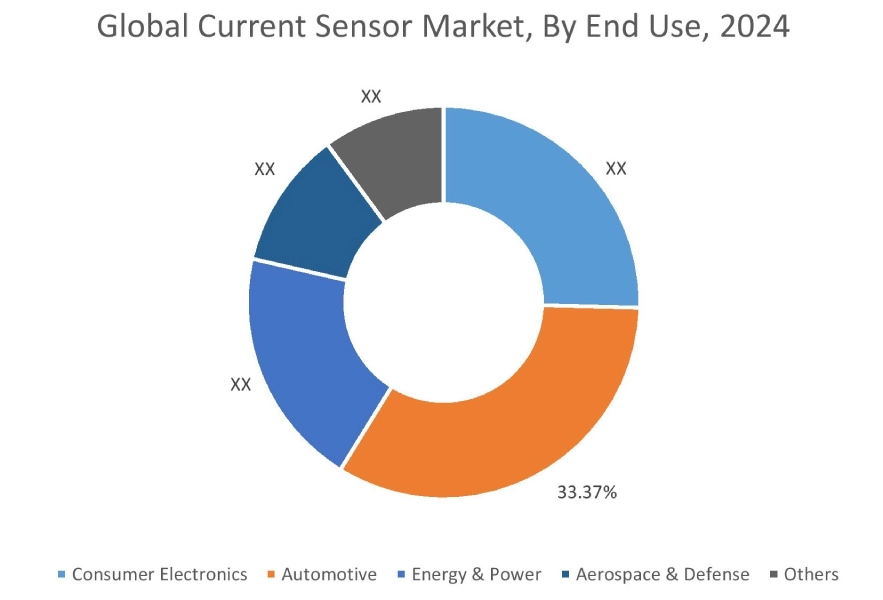
Regional Analysis:
The regions covered are North America, Europe, Asia Pacific, the Middle East and Africa, and Latin America.
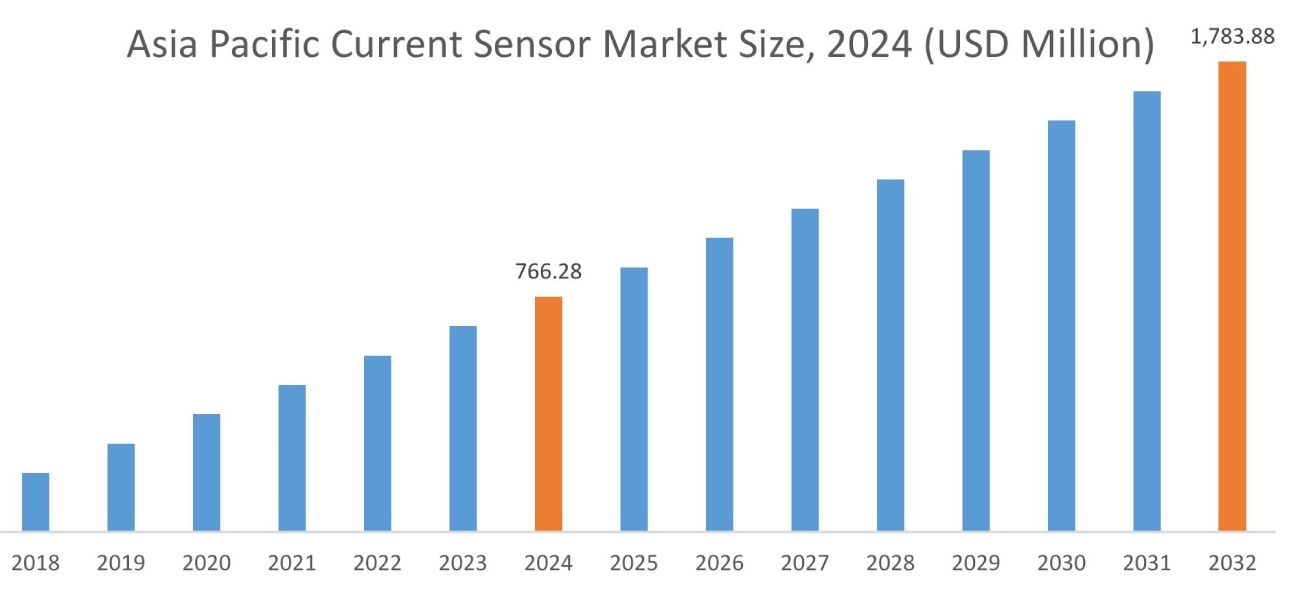
Asia Pacific region was valued at USD 766.28 Million in 2024. Moreover, it is projected to grow by USD 840.94 Million in 2025 and reach over USD 1,783.88 Million by 2032. Out of this, China accounted for the maximum revenue share of 33.78%. As per the current sensor market analysis, the adoption of these sensors in the Asia-Pacific region is primarily driven by the rising demand for improved battery efficiency in automotive, consumer electronics, aerospace, and other sectors in the region. Additionally, the rising adoption of these sensors in battery electric vehicles along with growing advancements related to industrial automation are further accelerating the current sensor market expansion.
- For instance, according to the International Federation of Robotics, China installed 276,288 industrial robots in the fiscal year 2023. Current detectors are used in robotics for monitoring and controlling motor performance. Hence, the above factors are further driving the market in the Asia-Pacific region.
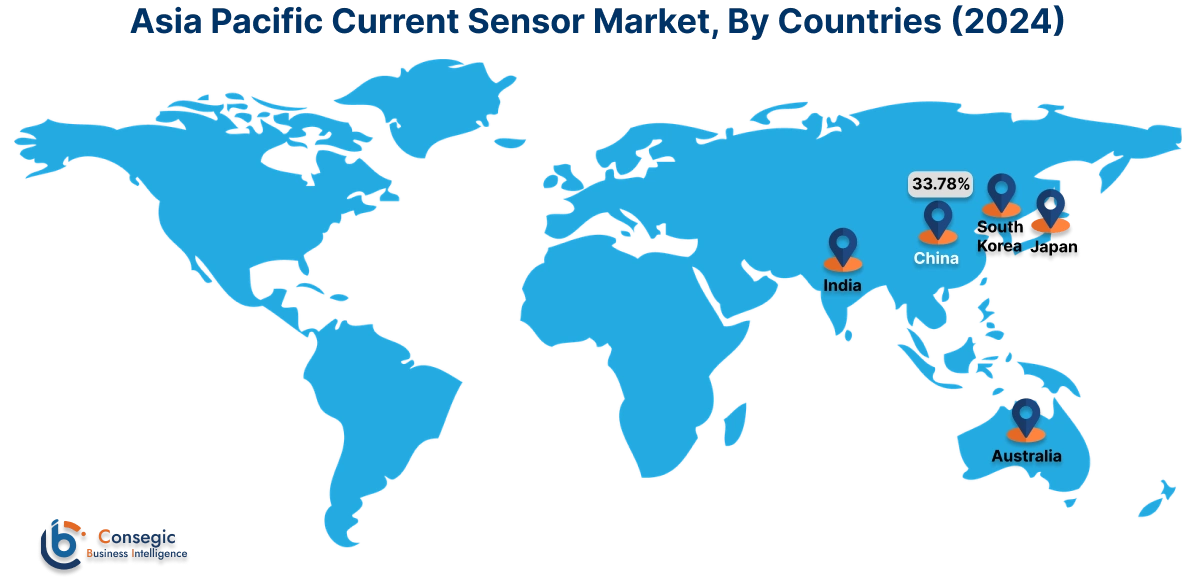
North America is estimated to reach over USD 1,436.05 Million by 2032 from a value of USD 646.39 Million in 2024 and is projected to grow by USD 706.57 Million in 2025. In North America, the adoption of these sensors is driven by increasing adoption of automation in automotive sector and rising adoption of smart grids in the region. Similarly, rising developments associated with automotive, energy, and aerospace industries are contributing to the current sensor market demand.
- For instance, Texas Instruments Corporation, a U.S. based company, offers a wide range of current sensors designed for fast, accurate, and safe high-voltage systems.
Additionally, the regional analysis depicts that the rising progressions in industrial automation and growing adoption of sensors in automotive, defense, and consumer electronics, due to its improved efficiency and enhanced power systems, are driving the current sensor market demand in Europe. Furthermore, as per the market analysis, the market demand in Latin America, Middle East, and African regions is expected to grow at a considerable rate due to factors such as significant investments in automotive, consumer electronics, and other industrial sectors, increasing technological advancements, growing need for enhanced current monitoring solutions among others.
Top Key Players and Market Share Insights:
The global current sensor market is highly competitive with major players providing solutions to the national and international markets. Key players are adopting several strategies in research and development (R&D), product innovation, and end-user launches to hold a strong position in the current sensor industry. Key players in the current sensor industry include-
- Honeywell International Inc. (U.S.)
- Sensitec GmbH (Germany)
- TDK Corporation (Japan)
- Tamura Corporation (Japan)
- V.P Electronics (India)
- Infineon Technologies AG (Germany)
- Omron Corporation (Japan)
- Allegro Micro Systems, Inc. (U.S.)
- Texas Instruments Incorporated (U.S.)
- Schneider Electric (France)
Recent Industry Developments :
Product Launch
- In January 2025, Allergo Micro Systems launched two new current sensor ICs, which are designed for precise current sensing in a durable package. Moreover, these current detectors offer various benefits such as a 40% smaller footprint, lower resistance, and reduced power dissipation.
Current Sensor Market Report Insights :
| Report Attributes | Report Details |
| Study Timeline | 2019-2032 |
| Market Size in 2032 | USD 4,969.02 Million |
| CAGR (2025-2032) | 9.4% |
| By Type |
|
| By Loop Type |
|
| By Application |
|
| By End Use |
|
| By Region |
|
| Key Players |
|
| North America | U.S. Canada Mexico |
| Europe | U.K. Germany France Spain Italy Russia Benelux Rest of Europe |
| APAC | China South Korea Japan India Australia ASEAN Rest of Asia-Pacific |
| Middle East and Africa | GCC Turkey South Africa Rest of MEA |
| LATAM | Brazil Argentina Chile Rest of LATAM |
| Report Coverage |
|
Key Questions Answered in the Report
What specific segmentation details are covered in the current sensors report? +
The current sensors report includes specific segmentation details for type, loop type, application, end use, and region.
How big is the current sensor market? +
The current sensor market was valued at USD 2,215.39 Million in 2024 and is projected to grow to USD 4,969.02 Million by 2032.
Which is the fastest-growing region in the current sensor market? +
Asia-Pacific is the region experiencing the most rapid growth in the current sensor market.
Who are the major players in the current sensor market? +
The key participants in the current sensor market are Honeywell International Inc. (U.S.), Sensitec GmbH (Germany), Infineon Technologies AG (Germany), Omron Corporation (Japan), Allegro Micro Systems, Inc. (U.S.), Texas Instruments Incorporated (U.S.), Schneider Electric (France), TDK Corporation (Japan), Tamura Corporation (Japan), V.P Electronics (India), and others.
